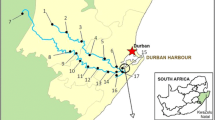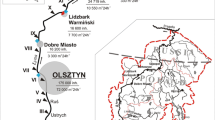Abstract
Concentrations of selected heavy metals (Cd, Cr, Cu, Pb, Ni, Fe, and Zn), nutrients (NO −3 and NH3), fecal coliform colonies, and other multiple physical–chemical parameters were measured seasonally from 12 locations in an urban New Jersey estuary between 1994 and 2008. Stepwise regression, principal component analysis, and cluster analysis were used to group water quality results and sampling locations, as well as to assess these data’s relationship to sewage treatment effluents and the distance to the mouth of the river. The BOD5, NH3, NO −3 and fecal coliform counts clustered as one group and positively correlated to the distances from treated effluent and the measures of magnitude at the discharge points. Dissolved solids and most metal species scored high along a single principal component axes and were significantly correlated with the proximity to the industrialized area. From these data, one can conclude that the effluent discharge has been a main source of anthropogenic input to the Hackensack River over the past 15 years. Therefore, the greatest improvement to water quality would come from eliminating the few remaining combined sewer overflows and improving the removal of nutrients from treated effluents before they are discharged into the creeks and river.









Similar content being viewed by others
References
Adachi, K., & Tainosho, Y. (2004). Characterization of heavy metal particles embedded in tire dust. Environmental International, 30(8), 1009–1017.
Artiola, J. F., Pepper, I. L., & Brusseau, M. L. (2004). Monitoring and characterization of the environment. In J. F. Artiola et al. (Eds.), Environmental monitoring and characterization (pp. 1–9). Boston: Elsevier Academic Press.
ASTM D4841. (1998). Standard practice for estimation of holding time for water samples containing organic and inorganic constituents. West Conshohocken: American Society for Testing and Materials. doi:10.1520/D4841-88R98.
Bierman, P., Megan, L., Bertram, L., & Tanner, J. (2009). A review of methods for analyzing spatial and temporal patterns in coastal water quality. Ecolological Indicators, 11(1), 103–114.
Brosnan, T. M., & O’Shea, M. L. (1996). Long-term improvements in water quality due to sewage abatement in the lower Hudson River. Estuaries and Coasts, 19(4), 890–900.
Buggy, C. J., & Tobin, J. M. (2008). Seasonal and spatial distribution of metals in surface sediment of an urban estuary. Environmental Pollution, 155(2), 308–319.
Carswell, L.D. (1976). Appraisal of water resources in the Hackensack River Basin, New Jersey. U.S. Geological Survey-Water Resources Investigations Report, 76–74.
Cheng, C., Konsevick, E. (1988). Trends in the water quality of an urban estuary: Hackensack Meadowlands, New Jersey. In Proceedings from the Coastal Water Resources Symposium (pp. 147–154). Wilmington, NC: American Water Resources Association.
Cliff, N. (1988). The eigenvalues-greater-than-one rule and the reliability of components. Psychological Bulletin, 103(2), 276–279.
Crawford, D. W., Bonnevie, N. L., Gillis, C. A., & Wenning, R. J. (1994). Historical changes in the ecological health of Newark Bay Estuary, New Jersey. Ecotoxicology and Environmental Safety, 29(3), 276–303.
DiLorenzo, J. L., Filadelfo, R. J., Surak, C. R., Litwack, H. S., Guawardana, V. K., & Najarian, T. O. (2004). Tidal variability in the water quality of an urbanized estuary. Estuaries and Coasts, 27(5), 851–860.
Ferrier, R. C., Edwards, A. C., Hirst, D., Littlewood, I. G., & Watss, C. D. (2001). Water quality of Scottish rivers: Spatial and temporal trends. The Science of the Total Environment, 265(1–3), 327–342.
Gutierrez, R. L., Rubio-Arias, H., Quintana, R., Ortega, J. A., & Gutierrez, M. (2008). Heavy metals in water of the San Pedro River in Chihuahua, Mexico and its potential health risk. International Journal of Environmental Research and Public Health, 5(2), 91–7827.
Kaiser, H.F., (1959). The application of electronic computers to factor analysis. Symposium on the Application of Computers to Psychological Problems. Washington, D.C.: American Psychological Association.
Kawabe, M., & Kawabe, M. (1997). Temporal and spatial characteristics of chemical oxygen demand in Tokyo Bay. Journal of Oceanography, 53(1), 19–26.
Kazi, T. G., Arain, M. B., Jamali, M. K., Jalbani, N., Afridi, H. I., Sarfraz, R. A., et al. (2009). Assessment of water quality of polluted lake using multivariate statistical techniques: A case study. Ecotoxicology and Environmental Safety, 72(2), 301–309.
Kelley, K. D., & Hudson, T. (2007). Natural versus anthropogenic dispersion of metal to the environment in the Wulik River area western Brooks Range, northern Alaska. Geochemistry: Exploration, Environment, Analysis, 7(1), 87–96.
Konsevick, E., Hobble, C.C., Lupini, P. (1994). Monitoring effects of urban land-use on estuarine water quality: Hackensack Meadowlands, New Jersey. In Proceedings from the National Symposium on Water Quality (pp. 181–190). Chicago: American Water Resources Association.
Li, S., & Zhang, Q. (2008). Geochemistry of the upper Han River basin, China, 1: Spatial distribution of major ion compositions and their controlling factors. Applied Geochemistry, 23(12), 3535–3544.
Marino, G.R., Strakosh, K., Ram, R.V., Gunawardana, V.K., Najarian, T.O. (1990). Impact analysis of sewage treatment plant discharges on the water quality of the lower Hackensack River. http://njedl.rutgers.edu/ftp/PDFs/1370.pdf. Accessed Sept 2010.
Mattson, C. P., & Vallario, N. (1976). Water quality in a recovering ecosystem: a report on water quality research and monitoring in the Hackensack Meadowlands, 1971–1975. Lyndhurst: Hackensack Meadowlands Development Commission.
Mattson, C., Potera, G., & Saks, M. E. (1971). Water quality in a disordered ecosystem: A report on the water quality monitoring study performed in the Hackensack Meadowlands between June and September 1971. Lyndhurst: Hackensack Meadowlands Development Commission.
McKenna, J. E. (2003). An enhanced cluster analysis program with bootstrap significance testing for ecological community analysis. Environmental Modelling & Software, 18(3), 205–220.
NJDEP. (2010). Surface Water Quality Standards (SWQS), 2010. N.J.A.C. 7:9B, NJDEP. http://www.nj.gov/dep/rules/rules/njac7_9b.pdf. Accessed 16 Dec 2010.
Ouyang, Y., Nkedi-Kizza, P., Wu, Q. T., Shinde, D., & Huang, C. H. (2006). Assessment of seasonal variations in surface water quality. Water Research, 40(20), 3800–3810.
Razmkhah, H., Abrishamchi, A., & Torkian, A. (2010). Evaluation of spatial and temporal variation in water quality by pattern recognition techniques: A case study on Jajrood River (Tehran, Iran). Journal of Environmental Management, 91(4), 852–860.
Shrestha, S., & Kazama, F. (2007). Assessment of surface water quality using multivariate statistical techniques: A case study of the Fuji river basin, Japan. Environmental Modeling & Software, 22(4), 464–475.
Simeonov, V., Stratis, J. A., Samara, C., Zachariadis, G., Voutsa, D., Anthemidis, A., et al. (2003). Assessment of the surface water quality in Northern Greece. Water Research, 37(17), 4119–4124.
Singh, K. P., Malik, A., Mohan, D., & Sinha, S. (2004). Multivariate statistical techniques for the evaluation of spatial and temporal variations in water quality of Gomti River (India)—A case study. Water Research, 38(18), 3980–3992.
SPSS. (2001). SPSS for Windows. Release 11.0.0. LEAD Technologies, Inc., Illinois, USA.
Stratton, C. L., & Lee, G. F. (1975). Cooling towers and water quality. Journal of the Water Pollution Control Federation, 47(7), 1901–1912.
Su, Y., & Yang, R. (2008). Background concentrations of elements in surface soils and their changes as affected by agricultural use in the desert-oasis ecotone in the middle of Heihe River Basin, Northern West China. Journal of Geophysical Exploration, 98(3), 57–64.
Suszkowski, D.J. (1978). Sedimentology of Newark Bay, New Jersey: An urban estuarine bay. Ph.D. Dissertation, University of Delaware, Newark, DE.
U.S. Geological survey. (2003). Water resources data, New Jersey, Water Year 2003. Volume 1, Surface water data. Water-data Report NJ-02-1. http://pubs.usgs.gov/wdr/WDR-NJ-03-1/pdf/WDR03.Vol1.pdf. Accessed 12 Nov 2010.
US EPA Office of Water Planning and Standards (WH 451). (1978). A water quality success story. Washington, DC: U.S. Environmental Protection Agency.
Versar, Inc. (1989). Review and evaluation of thermal effects studies and cooling water intake structure demonstrations of impact for the Bergen, Hudson, Kearny, Linden, and Sewaren Generating Stations: First progress summary (draft).
Willet, P. (1987). Similarity and clustering in chemical information systems. Wiley, New York: Research Studies Press.
Acknowledgments
The authors thank Joe Grzyb, Edward Konsevick, Yefim Levinsky, and Joseph Sarnoski for the field work and chemical analysis, as well as MERI GIS group for providing the geographical information. The authors also wish to thank Dr. Aridaman Jain of the New Jersey Institute of Technology for providing the statistical analysis for the data. This project was supported by the New Jersey Meadowlands Commission. Part of the statistical work on the manuscript was prepared by the Basic Science Research Program through the National Research Foundation of Korea, funded by the Ministry of Education, Science and Technology (Grant No. 2010-0009273).
Author information
Authors and Affiliations
Corresponding author
Rights and permissions
About this article
Cite this article
Shin, J.Y., Artigas, F., Hobble, C. et al. Assessment of anthropogenic influences on surface water quality in urban estuary, northern New Jersey: multivariate approach. Environ Monit Assess 185, 2777–2794 (2013). https://doi.org/10.1007/s10661-012-2748-0
Received:
Accepted:
Published:
Issue Date:
DOI: https://doi.org/10.1007/s10661-012-2748-0




